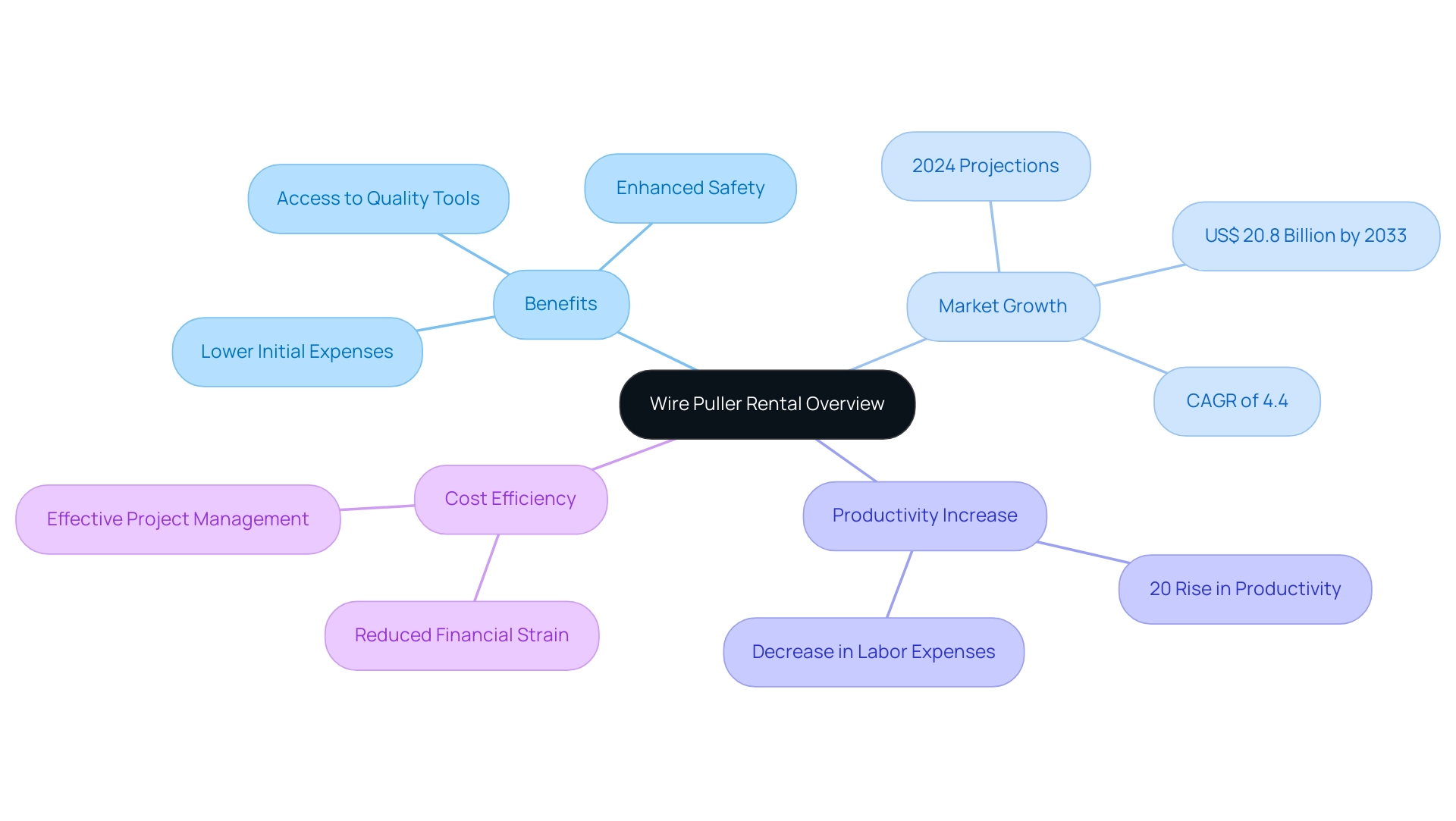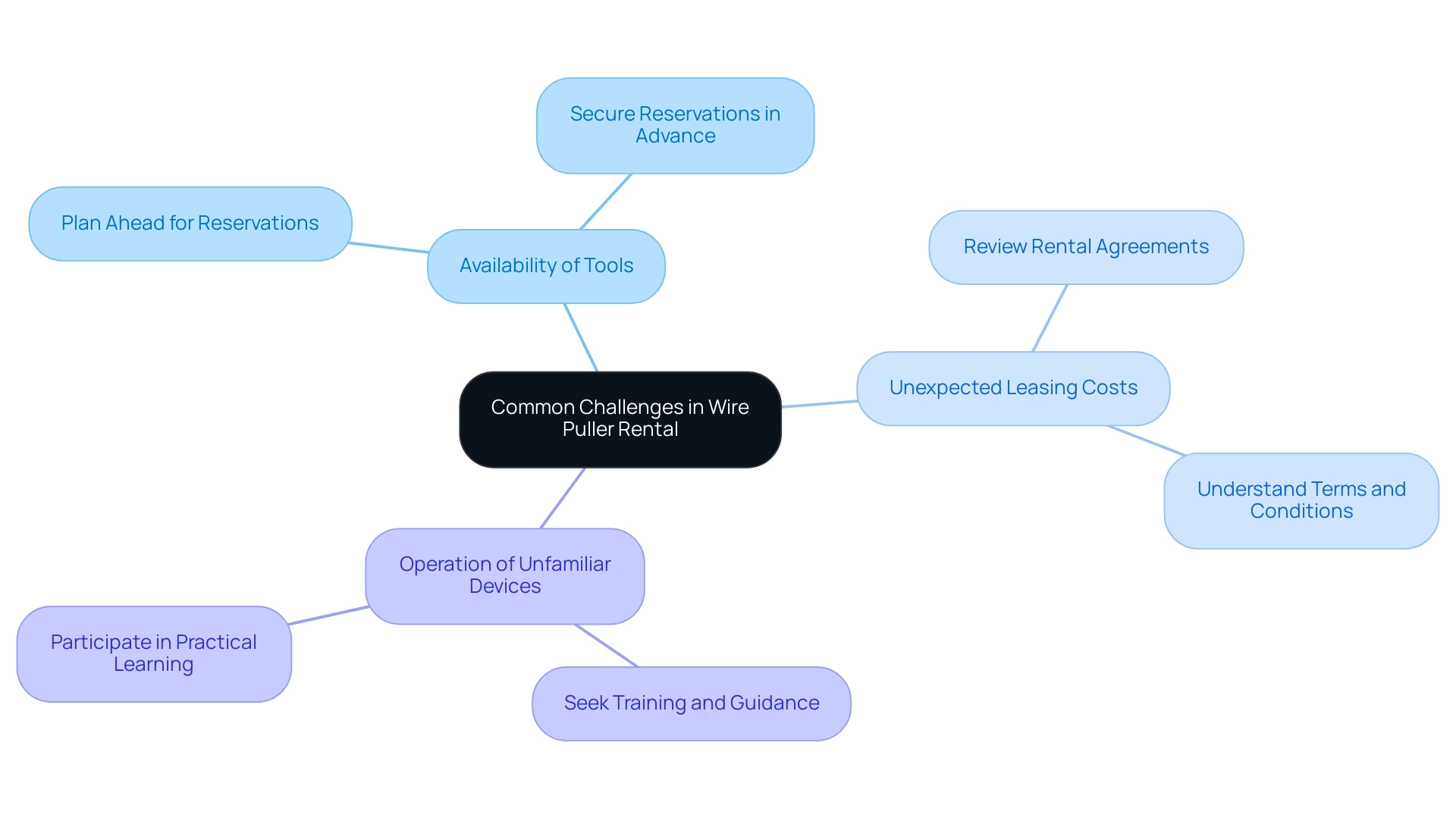Introduction
In the ever-evolving landscape of the construction and electrical industries, wire puller rentals have emerged as a vital solution for professionals seeking efficiency and cost-effectiveness. As projects grow in complexity and scale, the need for specialized equipment becomes paramount. Wire pullers, designed to streamline the process of pulling electrical cables through conduits, not only enhance productivity but also ensure safety on job sites. With the rental market projected to expand significantly, understanding the advantages of this approach can empower contractors to optimize their operations, reduce upfront costs, and adapt to the dynamic demands of their projects.
This article delves into the key benefits of wire puller rentals, the types available, best practices for maximizing rental experiences, and strategies to overcome common challenges, equipping professionals with the insights needed to navigate this essential aspect of their work effectively.
Understanding Wire Puller Rental: An Overview
Wire puller rental is a strategic practice within the construction and electrical sectors, allowing professionals to access specialized tools known as wire pullers. These tools are engineered to efficiently pull electrical cables through conduits, enhancing both safety and productivity during installations. For contractors and electricians, choosing a wire puller rental offers access to high-quality tools without the substantial financial strain linked to buying, maintaining, and storing these items.
This leasing model for wire puller rental is especially beneficial for short-duration assignments or particular tasks that need specialized tools for a limited time.
Recent statistics suggest that the wire extractor leasing market is anticipated to expand considerably in 2024, mirroring wider trends in the tool leasing sector. According to industry specialists, 'Wire puller rental not only lowers initial expenses but also guarantees that contractors possess the finest tools suited for their particular tasks, resulting in enhanced efficiency and safety on work sites.'
Furthermore, case studies have demonstrated that construction tasks using wire handling services have indicated a 20% rise in productivity and a decrease in labor expenses due to the effectiveness of the tools. As the machinery rental sector keeps growing, with forecasts showing an increase from US$ 13.5 billion in 2023 to US$ 20.8 billion by 2033, the importance of wire puller rental equipment becomes even more evident. Their role in facilitating electrical installations highlights the significance of having dependable tools readily accessible, enabling project managers to effectively meet project requirements while reducing costs.

Benefits of Renting Wire Pullers: Cost-Effectiveness and Flexibility
A wire puller rental presents a multitude of advantages, chief among them being cost-effectiveness and operational flexibility. By choosing rentals, companies can avoid the substantial upfront costs associated with acquiring tools, which is especially beneficial for small businesses or those functioning within tight budget restrictions. A recent analysis showed that the construction industry, with over 1.3 million residential units completed in 2021, increasingly relies on efficient resource management to meet growing demands.
Moreover, leasing allows companies to adjust their resource needs based on particular task requirements, facilitating smooth scaling up or down as required. For example, during peak construction seasons, contractors can utilize wire puller rental services to manage increased workloads, while scaling back during slower periods without the burden of ownership for tools that may see infrequent use. This adaptability means contractors can swiftly adjust to changing conditions.
As Moncure points out, when a contractor leases a piece of machinery, they also enhance their access to specialists who can assist their team in understanding the intricacies of complex devices. This expertise further enhances the advantages of renting, as it fosters a deeper understanding of the tools, ultimately leading to better results. Additionally, the integration of telematics in equipment management is revolutionizing how contractors track and utilize their assets, as highlighted in the case study on technological advancements in construction equipment leasing.
The rental model not only offers a pragmatic approach to managing costs but also ensures that contractors have the right tools at their disposal to navigate the ever-evolving landscape of construction.
Types of Wire Pullers Available for Rent
A varied selection of wire puller rental options is available, each customized to meet specific task requirements. Manual wire tools are particularly effective for smaller tasks, operated by hand, making them easy to use in tight spaces. In contrast, electric wire devices are designed for larger-scale projects, delivering significant pulling power with minimal physical effort.
These models often enhance efficiency, especially for extensive wiring installations. For heavy-duty applications, hydraulic wire devices are indispensable, providing the strength required to tackle substantial workloads. Notably, tensioners are typically hydraulically driven, making them suitable for overhead and underground transmission systems.
Recent innovations in wire pulling tools, including advancements in design and functionality, further expand the options available to contractors for wire puller rental. For instance, the Sheave Radius Cable, with its heavy-duty design featuring aluminum sheaves and a maximum capacity of 4,000 lbs, exemplifies the capabilities of hydraulic wire pullers. Grasping these distinctions is vital for choosing the most appropriate equipment according to the scale and scope of each task.
This knowledge enables construction managers to optimize their operations and ensure successful outcomes.
Best Practices for Renting Wire Pullers
For contractors aiming to enhance their rental experience for wire handlers, adhering to specific best practices is essential. First and foremost, a thorough assessment of requirements should be conducted to accurately determine the type and quantity of wire puller rental needed. This initial step is vital for aligning tools with assignment requirements effectively.
Effective communication with leasing firms is also crucial; discussing project timelines and outlining material requirements can prevent misunderstandings that frequently result in expensive delays. In fact, implementing customer relationship management (CRM) software has been shown to enhance customer retention by as much as 27%, highlighting the significance of maintaining robust relationships with service providers. Before agreeing to a lease, it is crucial to examine the machinery thoroughly to confirm it is in excellent working order, as this can prevent operational issues later.
Moreover, technological advancements in heavy machinery are important factors of growth in the global machinery leasing market, making it crucial for contractors to remain updated on the latest innovations. Taking the time to familiarize oneself with the device's operation is beneficial, allowing for smoother use and minimizing downtime. Ultimately, returning the equipment promptly and in its original condition fosters a positive relationship with the provider and helps avoid unnecessary fees.
By adhering to these guidelines, and considering wider trends such as the prevalence of earthmoving equipment in the rental market, contractors can improve their rental experience and contribute to the overall success of their endeavors.
Common Challenges in Wire Puller Rental and Solutions
Renting wire puller rental equipment can present several challenges that construction project managers must navigate effectively. One of the most pressing issues is the availability of the desired tools, especially during peak construction seasons when demand surges. To address this, it’s crucial for contractors to plan ahead and secure reservations well in advance, thereby minimizing the risk of equipment shortages.
Furthermore, unexpected leasing costs can pose significant challenges—late fees and damage charges can quickly escalate expenses. It is advisable to meticulously review rental agreements, ensuring a clear understanding of all terms and conditions before finalizing the rental. According to industry insights, average late fees for construction tools can range significantly, impacting overall project budgets.
Another common hurdle is the operation of unfamiliar devices, which can lead to inefficiencies or safety issues. To enhance operational efficiency and safety, it is essential to seek training or guidance from the wire puller rental service. Participating in discussions and practical learning opportunities, as highlighted during Point of Rental's International Conference, can further prepare operators with the essential skills to use leasing tools effectively.
Furthermore, with the Material Handling Equipment leasing sector anticipated to expand at a rate of 9.4% from 2024 to 2030, it is crucial for managers to remain updated on industry trends. As Josh Nickell, Vice President of the American Rental Association’s equipment segment, observes, 'These multi-year issues dampened the optimism that would otherwise exist,' highlighting the current challenges faced by the industry. Proactively addressing these challenges is key to optimizing rental experiences and ensuring project timelines remain intact, especially as recent news suggests the rental industry may experience some softness this year.

Conclusion
The growing reliance on wire puller rentals in the construction and electrical industries reflects a crucial shift towards efficiency and cost management. By renting specialized equipment, contractors can enhance productivity while minimizing upfront costs associated with purchasing and maintaining tools. This strategic approach not only allows for flexibility in scaling operations as project demands fluctuate but also ensures access to the latest technology without the burden of ownership.
Understanding the variety of wire pullers available for rent is essential for optimizing project outcomes. From manual to hydraulic models, selecting the right tool for specific tasks can significantly impact installation efficiency and safety. Additionally, adhering to best practices—such as thorough project assessments, clear communication with rental providers, and proper equipment inspection—can further enhance the rental experience, helping to avoid common pitfalls.
Despite potential challenges, such as equipment availability and unexpected costs, proactive planning and training can mitigate risks and streamline operations. By embracing the wire puller rental model, contractors position themselves to adapt to the evolving landscape of the construction industry, ensuring they remain competitive and capable of delivering high-quality results on every project.
Frequently Asked Questions
What is wire puller rental and why is it used?
Wire puller rental is a practice in the construction and electrical sectors that allows professionals to access specialized tools known as wire pullers. These tools are designed to efficiently pull electrical cables through conduits, improving safety and productivity during installations.
What are the benefits of choosing wire puller rental over purchasing?
Choosing wire puller rental offers access to high-quality tools without the significant financial burden of buying, maintaining, and storing them. It is particularly advantageous for short-duration assignments or specific tasks requiring specialized tools.
How is the wire puller rental market expected to grow?
The wire extractor leasing market is anticipated to expand considerably in 2024, reflecting broader trends in the tool leasing sector. The overall machinery rental sector is projected to grow from US$ 13.5 billion in 2023 to US$ 20.8 billion by 2033.
What impact does wire puller rental have on productivity and costs?
Case studies have shown that using wire handling services can lead to a 20% increase in productivity and a reduction in labor costs due to the efficiency of the tools.
How does wire puller rental support resource management for contractors?
Wire puller rental allows companies to adjust their resource needs based on specific task requirements, enabling them to scale up during busy periods and scale down during slower times without the burden of owning tools that may be infrequently used.
What additional expertise do contractors gain from renting equipment?
When contractors lease machinery, they often gain access to specialists who can help their team understand complex devices, leading to better results and a deeper understanding of the tools.
How is technology influencing the equipment rental model?
The integration of telematics in equipment management is revolutionizing how contractors track and utilize their rental assets, enhancing the overall efficiency of resource management in construction.




